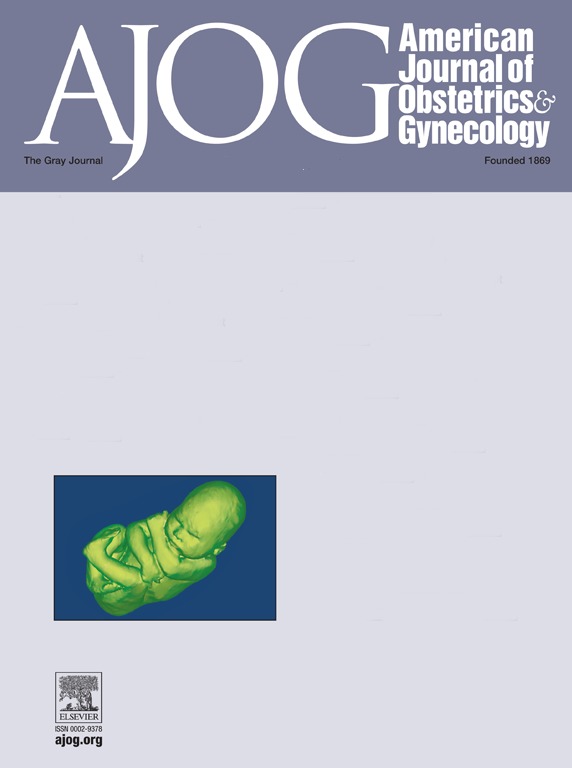Diagnostic Accuracy of Cell-Free DNA for the Determination of Fetal Red Blood Cell Antigen Genotype: A Systematic Review and Meta-Analysis.
IF 8.7
1区 医学
Q1 OBSTETRICS & GYNECOLOGY
引用次数: 0
Abstract
OBJECTIVE To evaluate the diagnostic accuracy of cfDNA in identifying fetal RBC antigen genotypes. DATA SOURCES A comprehensive systematic search was conducted across three databases between 2000 and 2024. STUDY ELIGIBILITY CRITERIA We included cohort studies utilizing cfDNA for fetal RBC antigen detection in pregnancies at risk of or with red cell alloimmunization. Two reviewers independently assessed the studies for inclusion, resolving any disagreements through discussion. STUDY APPRAISAL AND SYNTHESIS METHODS Reporting followed the Cochrane Handbook for Systematic Reviews of Diagnostic Test Accuracy and the Preferred Reporting Items for Systematic Reviews and Meta-Analyses (PRISMA) guidelines. Two authors independently extracted data and assessed the risk of bias using the quality assessment of diagnostic accuracy studies (QUADAS-2) tool. Pooled sensitivity and specificity were determined using a hierarchical summary receiver operating characteristic (HSROC) approach. The analysis was conducted for all studies and then per each laboratory technique, including polymerase chain reaction (PCR), next-generation sequencing (NGS), and Matrix-Assisted Laser Desorption/Ionization-Time of Flight (MALDI-TOF). Subgroup analyses were performed for each antigen type, including RhD, RhC, Rhc, RhE, Kell, and Duffy (Fya) antigens. RESULTS A total of 84 studies encompassing 77,187 antigen samples with neonatal genotype concordance were included. Seventy-six studies used PCR (75,692 antigen samples), five used NGS (328 antigen samples), and three used MALDI-TOF (1,167 antigen samples). Combining all lab techniques, the sensitivity and specificity of cfDNA in identifying fetal RBC antigen were 99% (95% CI 99-100). The diagnostic accuracy using i)PCR technique for the following antigens in order RhD (74,786 samples), RhC (189 samples), Rhc (232 samples), RhE (276 samples), and Kell (209 samples) were, the pooled sensitivity is 99% (95% CI 99,100), 100% (95% CI 98-100), 99% (95% CI 96-100), 100% (95% CI 97-100), and 99% (95% CI 96-100), respectively and the pooled specificity is 99% (95% CI 99-100), 100% (95% CI 98-100), 100% (95% CI 94-100), 100% (95% CI 99-100), 100% (95% CI 98-100), respectively, ii) NGS technique for the following antigens in order RhD (68 samples), RhC (42 samples), Rhc (52 samples), RhE (88 samples), and Kell (108 samples) were, the pooled sensitivity is 100% (95% CI 96-100), 100% (95% CI 92-100), 100% (95% CI 95-100), 100% (95% CI 95-100), and 100% (95% CI 90-100), respectively and the pooled specificity is 100% (95% CI 91-100), 100% (95% CI 93-100), 100% (895% CI 83-100), 100% (95% CI 97-100), and 100% (95% CI 98-100), respectively, and iii) MALDI-TOF technique studies only investigated RhD (1,167 samples) with sensitivity of 99% and specificity of 98%. Fya antigen (19 samples) was only available in the NGS technique (sensitivity and specificity of 100%). CONCLUSION CfDNA can accurately detect six fetal blood group antigens involved in red cell alloimmunization that can lead to severe fetal anemia. Integrating cfDNA into clinical practice for detecting fetal RBC antigens, particularly for RhD-negative pregnancies, can streamline care, reduce unnecessary treatment and monitoring, and decrease patient anxiety. Additionally, it can be performed earlier than amniocentesis.无细胞DNA检测胎儿红细胞抗原基因型的诊断准确性:系统回顾和荟萃分析。
目的评价cfDNA对胎儿红细胞抗原基因型的诊断准确性。数据来源esa在2000年至2024年间对三个数据库进行了全面的系统搜索。研究资格标准:我们纳入了使用cfDNA检测有红细胞异体免疫风险的孕妇胎儿红细胞抗原的队列研究。两名审稿人独立评估纳入研究,通过讨论解决任何分歧。研究评价和综合方法报告遵循Cochrane诊断测试准确性系统评价手册和系统评价和荟萃分析首选报告项目(PRISMA)指南。两位作者独立提取数据并使用诊断准确性研究质量评估(QUADAS-2)工具评估偏倚风险。采用分级汇总受者工作特征(HSROC)方法确定合并敏感性和特异性。对所有研究进行分析,然后对每个实验室技术进行分析,包括聚合酶链反应(PCR)、下一代测序(NGS)和基质辅助激光解吸/电离飞行时间(MALDI-TOF)。对每种抗原类型进行亚组分析,包括RhD、RhC、RhC、RhE、Kell和Duffy (Fya)抗原。结果共纳入84项研究,77,187份新生儿基因型一致性抗原样本。76项研究采用PCR法(75,692份抗原样本),5项研究采用NGS法(328份抗原样本),3项研究采用MALDI-TOF法(1167份抗原样本)。综合所有实验室技术,cfDNA鉴定胎儿红细胞抗原的敏感性和特异性为99% (95% CI 99-100)。诊断准确性使用以下抗原i) PCR技术为RhD(74786个样本),RhC(189个样本),RhC(232个样本),流值(276个样本),和凯尔(209个样本),汇集敏感性为99% (95% CI 99100)、100%(95%可信区间98 - 100),99% (95% CI 96 - 100)、100%(95%可信区间97 - 100年),和99%(95%可信区间96 - 100),分别和汇集特异性为99% (95% CI 99 - 100)、100%(95%可信区间98 - 100),100% (95% CI 94 - 100)、100%(95%可信区间99 - 100),100%(95%可信区间98 - 100),分别ii) NGS技术对以下抗原的检测顺序为RhD(68例)、RhC(42例)、RhC(52例)、RhE(88例)、Kell(108例),集合灵敏度分别为100% (95% CI 96 ~ 100)、100% (95% CI 92 ~ 100)、100% (95% CI 95 ~ 100)、100% (95% CI 95 ~ 100)、100% (95% CI 90 ~ 100),集合特异性分别为100% (95% CI 91 ~ 100)、100% (95% CI 93 ~ 100)、100% (895% CI 83 ~ 100)、100% (95% CI 97 ~ 100)、100% (95% CI 98 ~ 100);iii) MALDI-TOF技术研究仅调查了RhD(1167份样本),灵敏度为99%,特异性为98%。Fya抗原(19份)仅在NGS技术中可用(灵敏度和特异性均为100%)。结论cfdna能准确检测出6种与红细胞异体免疫相关的胎儿血型抗原。将cfDNA整合到临床实践中用于检测胎儿红细胞抗原,特别是对于rhd阴性妊娠,可以简化护理,减少不必要的治疗和监测,并减少患者的焦虑。此外,它可以比羊膜穿刺术更早进行。
本文章由计算机程序翻译,如有差异,请以英文原文为准。
求助全文
约1分钟内获得全文
求助全文
来源期刊
CiteScore
15.90
自引率
7.10%
发文量
2237
审稿时长
47 days
期刊介绍:
The American Journal of Obstetrics and Gynecology, known as "The Gray Journal," covers the entire spectrum of Obstetrics and Gynecology. It aims to publish original research (clinical and translational), reviews, opinions, video clips, podcasts, and interviews that contribute to understanding health and disease and have the potential to impact the practice of women's healthcare.
Focus Areas:
Diagnosis, Treatment, Prediction, and Prevention: The journal focuses on research related to the diagnosis, treatment, prediction, and prevention of obstetrical and gynecological disorders.
Biology of Reproduction: AJOG publishes work on the biology of reproduction, including studies on reproductive physiology and mechanisms of obstetrical and gynecological diseases.
Content Types:
Original Research: Clinical and translational research articles.
Reviews: Comprehensive reviews providing insights into various aspects of obstetrics and gynecology.
Opinions: Perspectives and opinions on important topics in the field.
Multimedia Content: Video clips, podcasts, and interviews.
Peer Review Process:
All submissions undergo a rigorous peer review process to ensure quality and relevance to the field of obstetrics and gynecology.

 求助内容:
求助内容: 应助结果提醒方式:
应助结果提醒方式:


